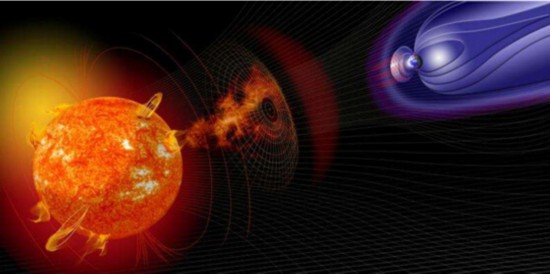能够提前24小时预测大型太阳风暴的新工具
摘要:原标题:能够提前24小时预测大型太阳风暴的新工具 中国科技网6月10日报道(张微 编译)能够影响GPS和电网技术的,来自太阳的大型磁暴,可能很快就会提前24小时得到预报。

中国科技网6月10日报道(张微 编译)能够影响GPS和电网技术的,来自太阳的大型磁暴,可能很快就会提前24小时得到预报。
日冕物质抛射(CME)是从太阳中喷发出的气体和磁性物质,有可能破坏卫星和地面技术,干扰无线电传输,导致变压器泄露和停电。
这些抛射物质能够引发GPS技术的诸多问题,而GPS技术在包括汽车到油轮到拖拉机的各种交通工具上有着广泛的应用。例如,它们可以影响飞机系统在着陆时精确判断飞机与地面距离的能力,导致飞机长达一个小时没法着陆。
但是,并不是从太阳到地球的每种抛射物质都能对地球造成这么多的干扰;这种力量取决于抛射物质中的磁场方向。目前,卫星只能在抛射物质接近地球的时候,才能明确地辨识出日冕物质抛射的磁场方向,发出一个30-60分钟的通知。这点时间不足以减轻对电网和GPS操作系统的影响。
现在,一个新的测量和建模工具可以提前24小时通知对地球有害的抛射物质到达地球的时间。伦敦帝国理工学院的校友和客座研究员,同时也是美国宇航局戈达德太空飞行中心的一位太空科学家尼尔 萨瓦尼博士领导的研究团队开发了这项技术,研究成果发表在今天出版的《Space Weather》期刊上。
“当越来越多的技术融合和集成在一起的时候,太空天气事件的干扰就会越来越多地影响我们的日常生活,”萨瓦尼博士说。“打破24小时预测瓶颈对于有效处理潜在的问题非常重要。”
日冕物质抛射的磁场方向取决于两件事情:它们从太阳喷发出来的最初形态,以及它们奔向地球过程中的演变。日冕物质抛射来自于太阳表面的两个区域,在抛射向太空和太阳表面之间形成一个牛角包状的一团日冕物质。
随着日冕物质的移动,里面的磁场方向也在发生改变。如果其中一个磁场与地球磁场的方向相同,那么两个磁场就会连接,“打开一扇门”让这些物质到达地球并引起地磁风暴。
此前,预测依赖于测量初始CME的爆发,但是对于CME爆发和日冕物质到达地球过程中的情况没有有效地建模。这项新技术仔细调查了日冕物质来自太阳的具体位置,利用一系列的观测来追踪和建模日冕物质的演变。
萨瓦尼博士和他的同事根据之前的八次日冕物质抛射情况,对该模型进行了测试,结果显示,对于改善目前影响地球的太阳风暴预测系统带来了巨大希望。如果美国宇航局支持进行进一步的测试,那么这个系统将很快在美国国家海洋和大气管理局以及英国气象局的地磁风暴预测中得到应用。
New tool could predict large solar storms more than 24 hours in advance
Large magnetic storms from the Sun, which affect technologies such as GPS and utility grids, could soon be predicted more than 24 hours in advance.
Coronal mass ejections (CMEs) are eruptions of gas and magnetised material from the Sun that have the potential to wreak havoc on satellites and Earth-bound technologies, disrupting radio transmissions and causing transformer blowouts and blackouts.
These mass ejections can cause problems with GPS technology - used by all kinds of vehicles, from cars to oil tankers to tractors. For example, they can affect the ability of aircraft systems to judge precisely a plane\'s distance from the ground for landing, leading to planes being unable to land for up to an hour.
However, not every mass ejection from the Sun that travels past the Earth causes this much disturbance; the power depends on the orientation of magnetic fields within the mass ejection. Currently, satellites can only tell the orientation of a mass ejection\'s magnetic field with any certainty when it is relatively close to the Earth, giving just 30-60 minutes\' notice. This is not enough time to mitigate the impacts on utility grids and systems operating on GPS.
Now, a new measurement and modelling tool could give more than 24 hours\' notice of mass ejections that could be harmful to systems on Earth. Details of the technique, developed by a team led by Dr Neel Savani, an alumnus and Visiting Researcher at Imperial College London and a space scientist at NASA\'s Goddard Space Flight Center, were published today in a paper in Space Weather.
"As we become more entwined with technology, disruption from large space weather events affects our daily lives more and more," said Dr Savani. "Breaking through that 24 hour barrier to prediction is crucial for dealing efficiently with any potential problems before they arise."
The orientations of magnetic fields within coronal mass ejections depend on two things: their initial form as they are erupted from the Sun, and their evolution as they travel towards Earth. Mass ejections originate from two points on the Sun\'s surface, forming a croissant-shaped cloud in between that discharges into space.
This cloud is full of twisted magnetic fields that shift as they travel. If one of these magnetic fields meets the Earth\'s magnetic field at a certain orientation, the two will connect, \'opening a door\' that allows material to enter and cause a geomagnetic storm.
Previously, predictions had relied on measuring the initial CME eruption, but were not efficient modelling what happened between this and the cloud\'s arrival at Earth. The new technique takes a closer look at where mass ejections originate from on the Sun and makes use of a range of observatories to track and model the evolution of the cloud.
Dr Savani and colleagues have tested the model on eight previous mass ejections, with the results showing great promise at improving the current forecasting system for large Earth-directed Solar storms. If further testing at NASA supports these initial results, the system could soon be used by NOAA in the US and the Met Office in the UK for geomagnetic storm predictions.
责任编辑:fl
(原标题:中国科技网 )
查看心情排行你看到此篇文章的感受是:
版权声明:
1.凡本网注明“来源:驻马店网”的所有作品,均为本网合法拥有版权或有权使用的作品,未经本网书面授权不得转载、摘编或利用其他方式使用上述作品。已经本网授权使用作品的,应在授权范围内使用,并注明“来源:驻马店网”。任何组织、平台和个人,不得侵犯本网应有权益,否则,一经发现,本网将授权常年法律顾问予以追究侵权者的法律责任。
驻马店日报报业集团法律顾问单位:上海市汇业(武汉)律师事务所
首席法律顾问:冯程斌律师
2.凡本网注明“来源:XXX(非驻马店网)”的作品,均转载自其他媒体,转载目的在于传递更多信息,并不代表本网赞同其观点和对其真实性负责。如其他个人、媒体、网站、团体从本网下载使用,必须保留本网站注明的“稿件来源”,并自负相关法律责任,否则本网将追究其相关法律责任。
3.如果您发现本网站上有侵犯您的知识产权的作品,请与我们取得联系,我们会及时修改或删除。

















 豫公网安备 41170202000005号
豫公网安备 41170202000005号